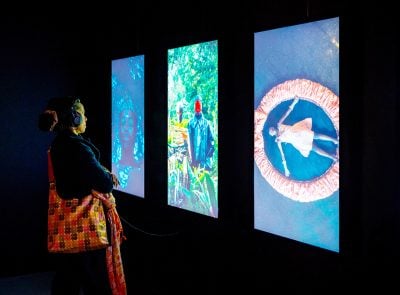For the first time, a landmark report on digitalisation for agriculture (D4Ag) in Africa compiles and highlights data on the digital solutions enabling transformation of the sector.
Digital technologies and innovations are putting Africa on the cusp of an exciting new agricultural revolution. As highlighted in a new study by CTA and Dalberg Advisors, which has provided the first analysis of its kind, digitalisation is a game-changer for agriculture.
According to the report, there are nearly 400 digital solutions for the 33m smallholder farmers registered across sub-Saharan Africa, with an annual growth of around 45% since 2012. Nevertheless, more than 90% of the market for digital services that support African smallholders remains untapped, with a turnover of an estimated €127m out of a total potential market of €2.3bn.
These figures are just a taste of what is revealed in the Digitalisation of African Agriculture Report 2018-19, which is to be launched in Africa at the 2019 African Green Revolution Forum.
Over 200 pages long, the research paints a clear picture of the recent emergence of digital solutions in African agriculture. It also presents a baseline geographical mapping of these applications and service providers including governments, mobile network providers, NGOs and other commercial actors. Critically, as well as surveying the D4Ag landscape, and providing valuable insight into the actual utilisation of digital solutions in agriculture across the continent (mainly Sub Saharan Africa), it also provides a forecast for the period 2025-2030. It thus shows what digital solutions have achieved to date, sets out prospects for growth in the short and medium-term and, above all, analyses what could be achieved by reaching the sector’s full potential.
“In the last decade, we have been working on promoting digital agriculture (ICT4Ag) solutions. Secondly, we have been supporting activities that enable the right environment for these solutions to work,” says Ben Addom, one of the study’s authors, and head of CTA’s ICTs for Agriculture team.
“The next 10 years will be [the] D4Ag decade, involving business development, and big data and analytics. Without viable business models behind the solutions, it is difficult to ensure sustained use by farmers and other intermediaries. And sustained use requires quality data and content, which is driven by big data and analytics.”
A barometer of digital agriculture
To be able to measure D4Ag progress every year or every two years, the CTA/ Dalberg report establishes a benchmark, acting as a kind of barometer: what does the digital ecosystem in African agriculture look like, who are its main actors, what impacts do different solutions have, what are their growth prospects, and who are their real users?
In all, 17 institutions have worked together as part of an advisory council to draw up a methodology, guide the data collection and provide feedback on the content.
The report classifies digital solutions for agriculture into five primary use cases (advisory services, market linkage, financial access, supply chain management, and macro agri-intelligence), subdivided into secondary categories. In addition, the experts have proposed new terms, such as ‘middleware’ to describe the data infrastructure necessary for the deployment of concrete digital solutions (drones, weather stations, soil, pest and crop diagnostics equipment, and field sensors).
Christian Merz, senior advisor at GIZ (Deutsche Gesellschaft für Internationale Zusammenarbeit), a member of the Report Advisory Council states that, “This landmark report provides desperately needed intelligence on the market for digital agriculture solutions in sub-Saharan Africa. All stakeholders across the sector need to understand size, character and coverage of the market to optimise interventions, select the best solution, define roll-out and go-to market strategies etc.”
Leonard Mizzi, Head of Unit at the European Commission, Directorate-General for International Cooperation and Development agrees: “We are living in an era of unprecedented transformation and technological change. Digitalisation can help stimulate innovation for sustainable agri
food systems and produce better and safer food while preserving natural resources and biodiversity. But we need to be conscious and support solutions that are sustainable and that are tailored to countries’ needs, and embedded into conducive and broader innovation systems.”
Digital disparities
Despite some impressive achievements in digital transformation, one of the key messages of the study’s analysis confirms the digital divide denounced by experts: women are under-represented, accounting for only a quarter of registered users of digital solutions, while representing about half of the agricultural workforce in sub-Saharan Africa. Given that, in Africa, 1 MB of mobile data costs on average 10% of the average monthly income, women – who often earn less than men – are left out. Yet digital solutions could increase their capacity to raise production of higher quality produce and boost sales.
Young people, on the other hand, are over-represented among registered users (70%), and digital technology can be a driver to attract or retain them in agriculture. At the same time, this figure likely also indicates an important age divide that must be overcome in order to engage the significant proportion of farmers from older groups.
Another striking trend highlighted by the analysis is that there are far more registered users in Eastern Africa, with Kenya leading the way, while paradoxically, there are more digital solutions in West Africa. Central and Southern Africa remain less represented overall. Nevertheless, despite the large number of players that make up this young market, only 15 companies have reached 1m users or more, accounting for 70% of the 33m registered farmers.
Scaling up
The report’s authors have focused on the number of registered users, which is of interest to donors. But they do not overlook the reality of the situation, that the number of active users is far lower. More than a third of users surveyed in the study said they used at least one form of advanced technology (drones, field sensors, big data or machine learning) but only 40% use it often, and very active users represent 1020% of all those registered. Yet, almost 60% of respondents stated that they expected to integrate these types of technologies into their operations in the next 3 years. Further, within 5 years, 87% of mobile phone users in sub-Saharan Africa should be connected to mobile internet, the report claims.
“This report indicates that despite challenges, the economics of D4Ag is rapidly improving, with a handful of players beginning to develop viable, large-scale businesses. To reach their full potential, companies will now need to focus on converting customer reach to actual use in order for this type of model to yield returns,” says Michael Hailu, CTA director.
This report demonstrates the real potential of the digital sector for African agriculture, and thus should convince other potential partners who are reluctant to get involved. There has been tangible progress in terms of performance and income, even if the data is still scarce. In order to provide a first set of data at a national level, CTA has therefore carried out more detailed analyses in Ethiopia, Ghana, Nigeria, Rwanda and Senegal, as well as analyses in Kenya and the Sahel. The collection and analysis of all this data, and the successful projects highlighted in the report, provide a solid basis for any individual or organisation in the agricultural and/or technological sectors interested in investing. This research raises awareness of the challenges and opportunities of digital technology, in Africa and across the developing world.
The digitalisation of agriculture provides agro-industry and governments with a better vision of their targets, enabling them to better adapt their products, services, policies and actions in general. Nevertheless, the report highlights that investment in digitalisation for agriculture to date has been isolated, scattered and piecemeal, with efforts to scale-up being duplicated, causing inefficiencies and hampering large-scale, long-term growth.
“While the opportunity is immense, the report is not naïve about the challenges that remain and the significant work required by agribusiness, governments, donors, and investors to maximise the transformative impacts of digital agriculture in years to come,” states Michael Tsan, partner at Dalberg Advisors and co-leader of the firm’s global Digital and Data Practice.
The need for all operators to be involved
All of the achievements highlighted show how important it is for all stakeholders to invest in digital technology for agriculture, from donors to major technology companies and the agro-industry as a whole; investments in the sector started out with mainly donor-driven financing, but the private sector is now catching up.
The study’s recommendations will be critical for the development of appropriate policies at national, regional, and continental levels, as well as for the development of human resources, public infrastructure and regulations. “The recommendations for actions to be implemented have the potential to transform the agricultural sector,” says Addom, pointing in particular at the need to build an alliance of all stakeholders and to avoid duplication of efforts.
According to Enock Chikava, a deputy director at the Bill & Melinda Gates Foundation, countries must start with a clear vision of their agriculture and its digitalisation potential. “Once you have the vision, there is a need for infrastructure. You cannot get into digital agriculture if the infrastructure will not allow connectivity, so we need regulations and policies to attract private sector investment,” he states. However, he does not shy away from reality, urging respect for the underlying motivation for digitalisation: “If the data already collected, standardised and analysed remains in the hands and control of the few, it defeats the whole purpose of digitalisation. It is only when the data is widely shared that newcomers do not have to spend the same amount of time collecting the same kind of data.”
“Digitalisation is a game changer in the transformation of small-scale agriculture but it must be given the importance it deserves in policies,” confirms Hailu. “Governments should consider digitalisation as a priority area, as it can have a strong impact on the transformation of agriculture, improving productivity, building resilience to climate change and creating opportunities for young people and women. Governments should seriously consider the benefits they could derive from digitalisation as part of their strategies for transforming agriculture.”
The way forward for D4Ag
As D4Ag develops, there is an opportunity to improve use and drive greater inclusivity and impact in Africa. But this must be done while actively managing the risks of digital tools, which will require sector actors to make several major investments in the improvement of business models and, especially, the D4Ag ecosystem. As efforts are made to mainstream D4Ag, the following recommendations from the CTA/ Dalberg report are provided to donors, governments and investors:
Develop human capital at every level of the D4Ag ecosystem. The necessary growth in human capital includes increased awareness of D4Ag, improved digital literacy and greater digital skill-building among smallholder farmers and other actors across the agricultural value chain, as well as the capacity of government staff to understand how to use and deploy D4Ag solutions in various public initiatives.
Drive greater business model sustainability. Key to this will be improving value for farmers, identifying and promoting successful business models and mobilising funding to support a more diverse set of companies.
Create greater impact by making D4Ag solutions more inclusive of women, other marginalised groups, and smallholders in regions with relatively less D4Ag investment. To achieve equitable growth, D4Ag needs to be more inclusive. Donors, in particular, can play a key role in catalysing greater targeting of marginalised communities.
Invest in the missing middleware infrastructure. Successful D4Ag solutions require access to a wide range of data (from remote sensing data to farmer-specific data) in order to deliver high-quality services to farmers. Coordination between governments, donors, investors, farmers and other interested parties will likely reduce duplication of efforts and result in better, efficient infrastructure that enterprises can rely on across regions.
Invest in good data stewardship and design for the risks and limitations of digital systems. Governments must design and implement approaches that suitably balance the need for data stewardship, with the desire not to over- regulate and stifle D4Ag innovation.
Invest in the D4Ag knowledge agenda. We recommend investments in three major areas: how to design user-centric offerings that meet the needs of farmers, especially women and other under-served groups; research to gather better market and business model intelligence to drive success in D4Ag; and research to gather more robust evidence on the impact of different-use cases and business models.
Create an alliance of key D4Ag stakeholders to promote greater investment, knowledge-sharing and partnership building. This alliance should be built as a partnership between governments, donors, international bodies, farmer organisations and the private sector dedicated to advancing inclusive, sustainable D4Ag across Africa and beyond.
Want to continue reading? Subscribe today.
You've read all your free articles for this month! Subscribe now to enjoy full access to our content.
Digital Monthly
£8.00 / month
Receive full unlimited access to our articles, opinions, podcasts and more.
Digital Yearly
£70.00 / year
Our best value offer - save £26 and gain access to all of our digital content for an entire year!
 Sign in with Google
Sign in with Google 


